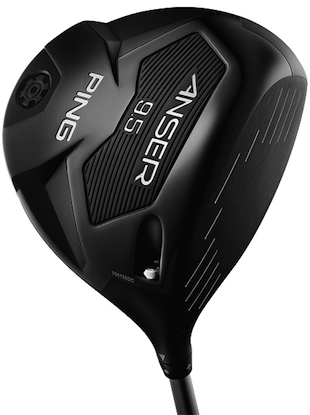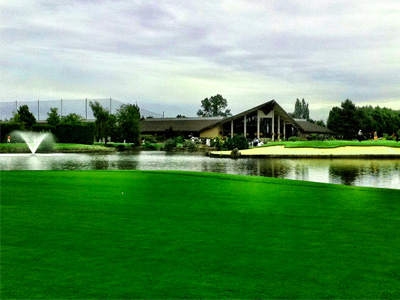 Welcome to Devil Ball’s Proving Ground, where we put the latest golf gear through its paces. Today, we take Ping’s Anser driver and fairway wood for a spin around the course.
Welcome to Devil Ball’s Proving Ground, where we put the latest golf gear through its paces. Today, we take Ping’s Anser driver and fairway wood for a spin around the course.
Tester — Jonathan Wall — Handicap: 2.1
Target Golf Audience — 0-15 handicapper
Ping has been designing adjustable clubs for years — the color coding system on their irons allows you to select the correct lie angle to suit a specific golfer — but for the first time in the company’s history, they have a driver that allows you to optimize launch.
Considering nearly every other major manufacturer has an adjustable driver on the market, you’re probably wondering what makes Ping’s new Anser line different from the rest. We decided to take the driver and 3-wood for a test drive to find out.
Initial thoughts
There’s a lot to like about the Anser, a 460-cc driver that’s a mix between the G20 (Ping’s “game improvement” driver) and the i20 (the “better player” option). Trying to blend drivers designed for different skill levels can be a slippery slope, but the Anser seems to be the best of both worlds wrapped up in one beautiful package.
The matte-black finish — first released with last year’s i20 — not only looks fantastic, it helps reduce glare on a sunny day. I fell in love with the color scheme last year and thought it was the right call to give the Anser an “i20 look.”
Another similarity to the i20 is the Anser’s curved crown, which is supposed to limit drag if you have a high swing speed. While the Anser is slightly larger, the overall profile remains intact. As a single-digit handicapper it’s nice to see Ping keep some of the same characteristics that made the i20 the perfect club for better players.
If you happen to by a high-handicapper, don’t worry: The Anser has an effective MOI that’s 9 percent greater than the i20 on mis-hits that are high or low on the face. What that essentially means you don’t have to hit it perfect every time to produce a positive result.
As far as the adjustability goes — you can adjust the loft + or – 1/2 degree — I’ll let Ping explain things for you:
When adding loft, the face angle closes slightly; when subtracting, the face angle opens slightly. However, our Trajectory Tuning Technology minimizes face-angle effects. This lets you fine-tune the height of your trajectory by changing loft before a round to suit the playing conditions, the weather, or changes in your swing.
Instead of having to mess with multiple settings on a driver, the Anser tweaks the face (slightly) and the trajectory with one simple adjustment. Embrace the simplicity, folks.
Another nice addition? The club has four different shaft options (Ping’s TFC800D, Aldila, Fujikura and Mitsubishi), thereby giving you the ability to mix and match depending on your swing and weight preference.
As far as the fairway woods are concerned, the Anser maintained a lot of the same i20 and G20 characteristic — shallow face, workability, incredible forgiveness — however, and maybe this is just me, but I thought the club actually sat tighter to the ground, giving you the ability to really go after the ball on closely mown fairways.
On-course thoughts
I had one concern when I started testing out the woods. Taking the best of the G20 and i20 seemed like a great idea, but I was incredibly skeptical Ping could build a driver that, for all intents and purposes, could work for high- and low-handicappers. It honestly seemed like they were putting all their eggs in one basket.
But within the first 40 or so balls I hit with the Anser, I realized that maybe Ping wasn’t so crazy after all. I mean, if some of the best players in the world — including British Open winner Louis Oosthuizen — could make the switch almost immediately, I could warm up to the driver as well.
Among the things I really liked about this driver was the additional carry I received — up 7 yards — and the reduced spin rate. After messing with the launch settings, I not only had a driver that was long, but also rolled out on drives that went down the middle. I also didn’t mind the fact that I could still work the ball from left to right — just like the i20 — without any problem.
Getting the Anser dialed in isn’t absolutely critical, but I’d recommend taking it to your local club professional to have them check your numbers. You’d be surprised how a slight tweak here or there could add an additional 5-10 yards to your drives.
I also felt like the variable thicknesses of the face allowed me to get away with mis-hits that likely would’ve been an issue with the i20. I think that’s where better players could get the most out of this club. While you may not be looking for forgiveness, having a driver that has a little bit of the G20 in it isn’t so bad.
Final verdict
I’ll be honest, I didn’t think it was possible to get the i20 driver out of the bag. Not only was it long off the tee, but I finally had a driver that gave me the confidence to work the ball and hit the fairway with regularity. Finding a stick that can do all of the above is downright impossible; however, after testing out Ping’s latest creation, I made the switch.
Why? Because this driver actually exceeded my lofty expectations — which is unfathomable. With my carry up from 285 yards to 292 yards and the spin rate down, it became apparent within a couple range sessions that this was the “Anser” to my driver dilemma. (Sorry, I had to go there.)
Price: $ 249 (fairway wood) – $ 399 (driver)
Got a product you want us to review here at Devil Ball? Shoot us an email at jonathanrwall@yahoo.com or reach us on Twitter at @jonathanrwall.
Devil Ball Golf – Golf – Yahoo! Sports
Other Related Posts:
The player-caddie relationship in professional golf is very much like a mar...
Ever since Rory McIlroy burst onto the golf scene as a fresh-faced 17-year...
Lee Scarbrow demonstrates how to put spin on the golf ball to improve your ...
The 17th at TPC Sawgrass is meant to be evil. Sitting out there just 130 or...
Stephen Curry, golfer? (Getty) Let’s say you operate a tournament on the We...
















